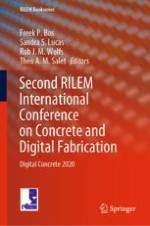
2020 | OriginalPaper | Buchkapitel
An Fe-Rich Slag-Based Mortar for 3D Printing
verfasst von : Glenn Beersaerts, Sandra S. Lucas, Yiannis Pontikes
Erschienen in: Second RILEM International Conference on Concrete and Digital Fabrication
Aktivieren Sie unsere intelligente Suche, um passende Fachinhalte oder Patente zu finden.
Wählen Sie Textabschnitte aus um mit Künstlicher Intelligenz passenden Patente zu finden. powered by
Markieren Sie Textabschnitte, um KI-gestützt weitere passende Inhalte zu finden. powered by